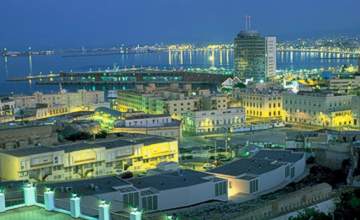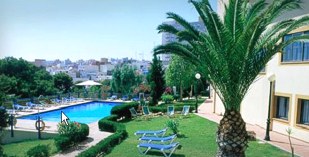
Melilla, North AfricaMelilla is a Spanish territory off the coast of Morocco in northern Africa. Originally, a Phoenican settlement, it later became part of the Roman province of Mauretania Tingitana and a defensive wall was built around the city during the 1st century to protect it from attack. Even once Spain had control many centuries later, it continued to be quite a struggle protecting the colony. Melilla was under siege from the surrounding Moroccan tribes for fifty years during the latter half of the 17th century, and it was not until 1859 that peace treaties were signed between Spain and Morocco, making Melilla an enclave, which is a territory entirely surrounded by another territory.  Ciudadela de Melilla was a fortress built during the 15th century on a rock mass that connected to the mainland by an isthmus (a small strip of land). The Caves of Conventico were excavated into the rock to act as a refuge during attacks, and religious services were held in them during times of war. As a tourist you can visit the military forts that still stand today, such as the Fort of Victory, Fort San Miguel and Fort San Carlos. There are also several interesting museums such as the Torre de la Vela, which is the current location of the Museum of Archaeology and History of Melilla. Others include the Military museum, and the Museum Amazigh that has a collection of ancient ceramics and jewellery.
Ciudadela de Melilla was a fortress built during the 15th century on a rock mass that connected to the mainland by an isthmus (a small strip of land). The Caves of Conventico were excavated into the rock to act as a refuge during attacks, and religious services were held in them during times of war. As a tourist you can visit the military forts that still stand today, such as the Fort of Victory, Fort San Miguel and Fort San Carlos. There are also several interesting museums such as the Torre de la Vela, which is the current location of the Museum of Archaeology and History of Melilla. Others include the Military museum, and the Museum Amazigh that has a collection of ancient ceramics and jewellery.
Melilla used to be a free port before Spain joined the European Union, and consequently the markets always have an extensive range of goods from Africa and the Middle East. If you cross over into Moroccan territory, the Oujda and Uled Mimon markets are also worth a visit. There are two very attractive parks in Melilla which are like an oasis in the hot weather. The Hernandez Park is filled with exotic plants and palm trees, and the Lobera Park is more on the outskirts. The latter is where you will find the Parador Melilla (Hotel Hostal Don Pedro de Estopinan), a 3 star hotel with fabulous views of the town and the bay below. From the terrace you can see the beach and the walled city of Pueblo, a perfect setting while you enjoy some excellent local cuisine, which is a wonderful mixture of both the Andalusian and Arab cultures. Most of the tourist activities in the area revolve around water sports and include swimming, scuba diving, and sailing. There are also many fascinating sites to visit such as the Mosque, the Synagogue, and the Purisima Conception Church. Towards the Bay of Alhucemas is the Ras el Ma which is a salty marsh area that draws in many visitors, as well as the Rostrogordo pine forests. The Spanish love putting on festivals, and although Melilla is a colony far removed from the Spanish mainland it is no exception. In September they hold the Virgin of Victoria festival and the Pedro Estopinan festival in honour of the founder of the city. So if you looking for a destination that offers wonderful weather, a bit of culture, a festive atmosphere and an array of water sports, Melilla is a serious contender. |